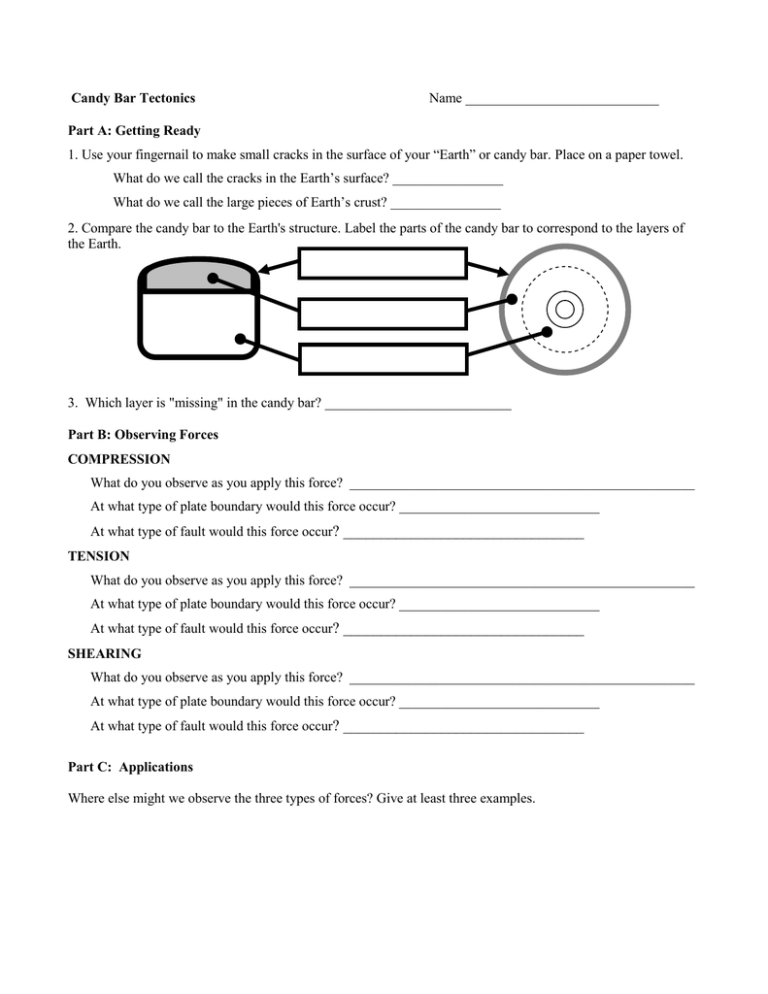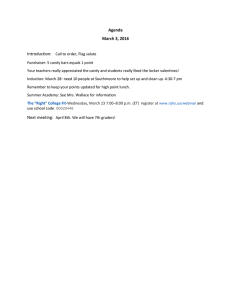Candy Bar Tectonics
advertisement

Candy Bar Tectonics Name ____________________________ Part A: Getting Ready 1. Use your fingernail to make small cracks in the surface of your “Earth” or candy bar. Place on a paper towel. What do we call the cracks in the Earth’s surface? ________________ What do we call the large pieces of Earth’s crust? ________________ 2. Compare the candy bar to the Earth's structure. Label the parts of the candy bar to correspond to the layers of the Earth. 3. Which layer is "missing" in the candy bar? ___________________________ Part B: Observing Forces COMPRESSION What do you observe as you apply this force? __________________________________________________ At what type of plate boundary would this force occur? _____________________________ At what type of fault would this force occur? ________________________________ TENSION What do you observe as you apply this force? __________________________________________________ At what type of plate boundary would this force occur? _____________________________ At what type of fault would this force occur? ________________________________ SHEARING What do you observe as you apply this force? __________________________________________________ At what type of plate boundary would this force occur? _____________________________ At what type of fault would this force occur? ________________________________ Part C: Applications Where else might we observe the three types of forces? Give at least three examples. Candy Bar Tectonics Answer Key Part A: Getting Ready 1. Use your fingernail to make small cracks in the surface of your “Earth” or candy bar. Place on a paper towel. What do we call the cracks in the Earth’s surface? Faults What do we call the large pieces of Earth’s crust? Plates 2. Compare the candy bar to the Earth's structure. Label the parts of the candy bar to correspond to the layers of the Earth. Crust Upper Mantle (Asthenosphere) Lower Mantle 3. Which layer is "missing" in the candy bar? Core Part B: Observing Forces COMPRESSION What do you observe as you apply this force? The pieces of chocolate move together with some going over the others or two pieces push upwards together (arch) At what type of plate boundary would this force occur? Convergent At what type of fault would this force occur? Reverse (& thrust) TENSION What do you observe as you apply this force? The pieces of chocolate spread apart; some may "drop" into the caramel layer At what type of plate boundary would this force occur? Divergent At what type of fault would this force occur? Normal SHEARING What do you observe as you apply this force? The pieces of chocolate "slide" in different directions At what type of plate boundary would this force occur? Transform (or lateral) At what type of fault would this force occur? Strike-Slip Part C: Applications Where else might we observe the three types of forces? Give at least three examples. Answers will vary Sample: Winds can cause shearing to occur on skyscrapers or the weight of the building might cause compression in the lower levels.
